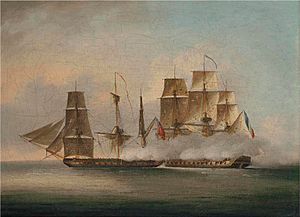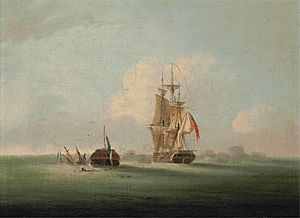Action of 10 August 1805 facts for kids
Quick facts for kids Action of 10 August 1805 |
|||||||
|---|---|---|---|---|---|---|---|
| Part of the Trafalgar campaign of the War of the Third Coalition | |||||||
 H.M. frigate Phoenix, attacking the French frigate La Didon. Francis Sartorius the younger. |
|||||||
|
|||||||
| Belligerents | |||||||
| Commanders and leaders | |||||||
| Strength | |||||||
| 1 frigate | 1 frigate | ||||||
| Casualties and losses | |||||||
| 12 killed 28 wounded |
1 frigate captured 27 killed 44 wounded 260 captured |
||||||
The Action of 10 August 1805 was a small but important sea battle. It happened between two fast warships called frigates. One was British, HMS Phoenix, and the other was French, Didon.
This fight was part of the larger Napoleonic wars. After about an hour of intense fighting, the French ship Didon gave up to the British ship Phoenix.
Contents
What Happened Before the Battle?
Captain Thomas Baker took charge of HMS Phoenix in 1803. His ship was part of the British Channel Fleet. On August 10, 1805, he was sailing near Cape Finisterre when he spotted the French frigate Didon.
Before this, Phoenix had stopped an American merchant ship. This ship was sailing from France to the United States. The American captain visited Phoenix and even sold some wine to the British crew.
During his visit, the American captain saw that Phoenix had been changed. From a distance, it looked like a smaller warship called a sloop-of-war.
Later, the French ship Didon stopped the same American merchant. The American captain told the French that a small 20-gun British ship was nearby. He even suggested it might be silly enough to attack Didon.
Captain Pierre Milius, who commanded Didon, decided to wait for the British ship. He thought it would be an easy win and he could capture it.
The Battle Begins
On August 10, 1805, the two ships met near Cape Finisterre. Phoenix managed to get close to Didon before the French realized it was a much larger frigate than they expected.
At 8 AM, Didon raised its French flag. About an hour later, the battle started. Didon fired first as Phoenix approached.
Captain Baker of Phoenix wanted to sail past the French ship and attack from its leeward side (the side away from the wind). This would give his ship an advantage.
However, Didon fired directly at the front or back of Phoenix (called "raking fire"). This caused a lot of damage. So, Baker decided to get closer to the French ship instead.
Phoenix pulled up right next to Didon, so close they were "within pistol shot." But Phoenix was moving too fast and sailed ahead of the French ship.
Didon quickly turned and fired another "raking broadside" (all guns on one side firing at once) at the back of Phoenix. Then, Didon turned again to try another raking shot.
But Captain Baker quickly moved Phoenix to stop this. The French crew then tried to board Phoenix (jump onto the British ship to fight hand-to-hand). However, the British Royal Marines fought them off.
After about 45 minutes of fighting, a strong breeze came up. This caused Didon to move forward, bringing more of Phoenix's guns into play. The ships were once again side-by-side, firing at each other.
The powerful guns of Phoenix soon began to win. After a short time, the two ships pulled apart.
Phoenix quickly fixed some of its damage. It was about to attack again when Didon's front mast suddenly broke and fell over. This left the French ship badly damaged and unable to move well.
Because of this damage and many injured sailors, Didon finally lowered its flag, which meant they surrendered. The battle had lasted several hours.
During the fight, Captain Baker even had his hat shot off his head! Phoenix had 12 sailors killed and 28 wounded. The French ship Didon had 27 killed and 44 wounded. The British also captured 260 French sailors.
What Happened Next?
By stopping the ship carrying messages for the French admiral, Baker unknowingly helped set the stage for the famous Battle of Trafalgar. But he played an even bigger role a few days later. He might have even helped prevent Napoleon's invasion of England.
Years later, in 1847, the British Navy gave out the Naval General Service Medal. It had a special "Phoenix 10 Augt. 1805" clasp for all surviving sailors from this battle.
While sailing to Gibraltar with the captured Didon, Captain Baker met another British ship, the 74-gun HMS Dragon. This was on August 14.
The very next day, the main French and Spanish fleet, led by Admiral Villeneuve, saw the three British ships. Villeneuve was heading to Brest and then to Boulogne. His job was to escort Napoleon's invasion forces across the Channel to England.
Villeneuve thought the three British ships were scouts from the main British fleet. To avoid a big battle, he turned his fleet south and sailed away.
Napoleon was furious when he heard this. He famously said, "What a Navy! What an admiral! All those sacrifices for nought!"
Villeneuve's decision to turn south was a huge moment in the Trafalgar Campaign. It meant he gave up all hope of controlling the English Channel for the invasion. Because of this, Napoleon gathered his invasion army, which he renamed the Grande Armée, and marched them east to attack the Austrians in the Ulm Campaign.
The British ships changed their course and sailed to Plymouth. They arrived on September 3. On the way, they even stopped an attempt by their French prisoners to capture Phoenix and retake Didon.
Images for kids
-
H.M. frigate Phoenix, attacking the French frigate La Didon. Francis Sartorius the younger.
See Also




